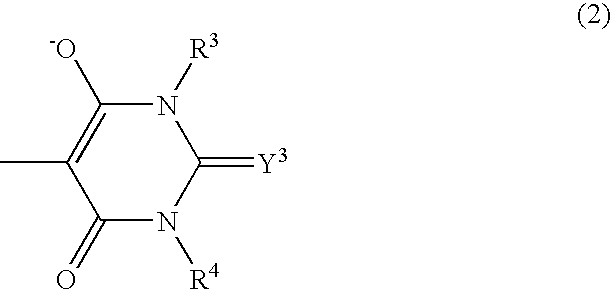Lithographic printing method and presensitized plate
a technology of presensitized plate and lithographic printing method, which is applied in the direction of auxillary/base layers of photosensitive materials, instruments, photosensitive materials, etc., can solve the problems of increasing the need for a solution to the above problem, restraining the press, and not being suitable for presensitized plates, etc., to achieve improved press life, low cost, and durable
- Summary
- Abstract
- Description
- Claims
- Application Information
AI Technical Summary
Benefits of technology
Problems solved by technology
Method used
Image
Examples
example 1-1
[0387] Next, an image recording layer-forming coating liquid A of the composition indicated below was prepared. Immediately following preparation, the coating liquid was applied with a wire bar to the support obtained as described above, then dried at 115.degree. C. for 45 seconds using a hot air drier, thereby forming an image recording layer and completing production of a negative-type presensitized plate P-1. The coating amount, after drying, was 1.0 g / m.sup.2. Composition of Image Recording Layer-Forming Coating liquid A:
10 Infrared absorber (IR-2 in the first aspect) 0.05 g Radical generator (OS-7 above) 0.2 g Monomer compound of the following formula below 1.3 g 49
[0388]
11 Poly (allyl methacrylate) (weight-average molecular 0.5 g weight, 120,000) Victoria Pure Blue, naphthalenesulfonate 0.02 g Fluorine containing surfactant of the following 0.1 g formula 50 Methyl ethyl ketone 18.0 g
examples 1-2 to 1-7
[0389] Aside from changing the types of infrared absorber and radical generator used in the respective examples to those shown in Table 1, negative-type presensitized plates P-2 to P-7 were obtained in the same way as in Example 1-1.
example 1-8
[0390] Aside from using a copolymer of allyl methacrylate and sodium methacrylate (molar ratio, 80:20) instead of poly(allyl methacrylate), a negative-type presensitized plate P-8 was obtained in the same way as in Example 1-1.
PUM
| Property | Measurement | Unit |
|---|---|---|
| wavelengths | aaaaa | aaaaa |
| wavelengths | aaaaa | aaaaa |
| wavelength range | aaaaa | aaaaa |
Abstract
Description
Claims
Application Information
 Login to View More
Login to View More - R&D
- Intellectual Property
- Life Sciences
- Materials
- Tech Scout
- Unparalleled Data Quality
- Higher Quality Content
- 60% Fewer Hallucinations
Browse by: Latest US Patents, China's latest patents, Technical Efficacy Thesaurus, Application Domain, Technology Topic, Popular Technical Reports.
© 2025 PatSnap. All rights reserved.Legal|Privacy policy|Modern Slavery Act Transparency Statement|Sitemap|About US| Contact US: help@patsnap.com



